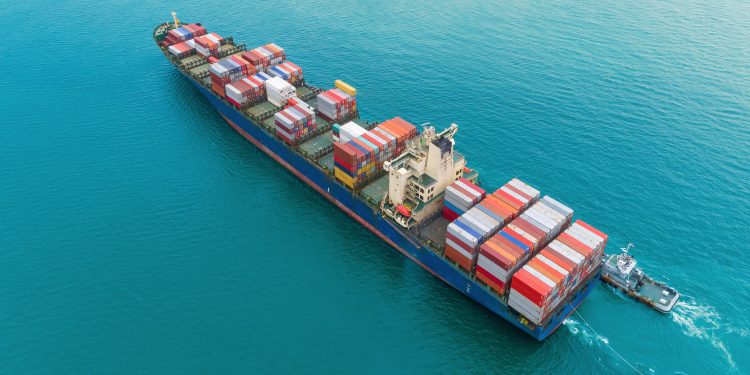The Mærsk Mc-Kinney Møller Center for Zero Carbon Shipping published a report, providing a technical, environmental, and techno-economic analysis of the impacts of preparing container ships for conversion to green fuels.
Converting from fuel oil to methanol or ammonia
The Center for Zero Carbon Shipping proposed general design of methanol-fuel oil and ammonia-fuel oil dual fuel vessels based on a 15 000 TEU twin island reference container vessel.
We found that under the accommodation was the most optimal location for the alternative fuel tanks, as this position has the smallest impact on cargo space
However, tanks cannot be retrofitted in this position due to the existing ship structure, so vessels must be prepared for conversion at newbuild. When ships aren’t prepared, methanol or ammonia tanks must be installed in the cargo space during conversion.
Using designs combined with cost estimations from suppliers and project partners, the report determined that methanol and ammonia dual fuel newbuilds should cost approximately 11 and 16% of a standard newbuild cost, respectively.
It also calculated that conversion from fuel oil to a full range methanol or ammonia dual fuel vessel costs 10-16 and 19-24% of a standard newbuild cost, respectively, depending on the level of preparation at newbuild.
For dual fuel newbuilds and conversions, converting to methanol is less expensive than converting to ammonia. This is partly because fuel tanks can be sized for methanol, installed at newbuilding and used for fuel oil before conversion. However, this is not possible for ammonia tanks, which are already more expensive than methanol tanks
In addition, the report’s model showed that fully capable dual fuel newbuilds with full-sized tanks integrated from newbuilding are the most cost-effective option if operators plan to convert vessels after a relatively short time operating on fuel oil only (5-8 years for full range conversion).
For methanol conversions, a conversion-ready vessel is the best option from a total cost perspective if you are planning a medium-term conversion. For ammonia conversions, the cost difference between converting a prepared or unprepared vessel is minimal because the expensive tank system cannot be prepared at newbuild, so there is no medium-term option.
The significant cargo costs associated with converting unprepared vessels to methanol or ammonia mean that this strategy only makes sense after 8-10 years of operation when the increased earning potential from using the full cargo space before the conversion can balance out the increased cost of conversion and larger cargo losses after conversion.
Converting from LNG to ammonia
Converting from LNG to ammonia is less complex than converting from fuel oil to ammonia, as many of the gas related systems required for ammonia are already in place.
In cases where the existing LNG tanks cannot be prepared for ammonia, we do not expect that it will be practically possible to replace the LNG tanks located under the accommodation, and as a result, conversion to ammonia would not be feasible.
As a result, LNG vessels must be compatible with liquid ammonia storage from newbuild for a conversion to take place.
We proposed designs for conversion to full range on ammonia (20 000 m3 LNG/ammonia tank) and reduced range (12 000 m3 LNG/ammonia) (Figure 6). After conversion, these ships become ammonia-fuel oil dual fuel vessels and can no longer operate on LNG
These designs, which prepare the vessels for vessel for later conversion, increase the cost of a newbuild by 7% and 2% for full range and reduced range, respectively, compared to a standard LNG-fuel oil newbuild. Conversion costs were 8% of an LNG newbuild, resulting in total additional costs for newbuild and conversion of 15 and 10% for full and reduced range, respectively. This is 33 and 28%, respectively, of a standard fuel oil newbuild cost.
The additional costs of preparing a vessel for LNG, a larger tank for ammonia operation, and then converting to ammonia make this strategy relatively expensive. However, based on a normalized fuel market situation, operating on LNG rather than fuel oil before conversion offers fuel cost savings.
We included fuel savings in our techno-economic model of this option, along with newbuild, conversion, and cargo loss costs. We found that LNG-ammonia conversions are cost-effective if conversion takes place after eight years of LNG operation for full range vessels and one year for reduced range vessels
Preparing for alternative fuels is feasible and cost-effective
To decarbonize the shipping industry, shipping must transition its fleets to alternative fuels. The analysis shows that converting vessels is technically and economically feasible, and can play a role in transitioning the fleets to alternative fuels.
What’s more, conversion has a favorable impact on lifetime emissions. However, intelligent vessel design and careful conversion and operational planning are essential to ensure conversion remains cost-effective.






























































